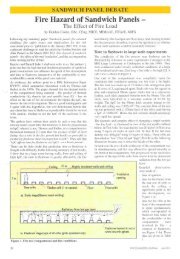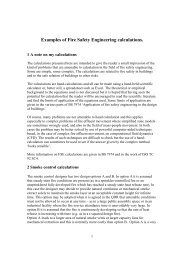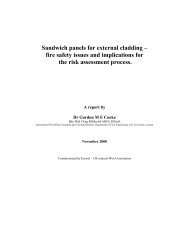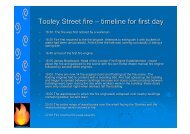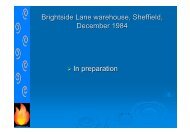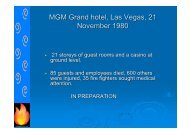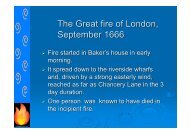Paris Charity Bazaar, 1897
Paris Charity Bazaar, 1897
Paris Charity Bazaar, 1897
Create successful ePaper yourself
Turn your PDF publications into a flip-book with our unique Google optimized e-Paper software.
<strong>Paris</strong> <strong>Charity</strong> <strong>Bazaar</strong>, <strong>1897</strong>‣ On 4 May <strong>1897</strong> a fire in a charity hall on the banksof the Seine caused the deaths of 124 people andwas famous because many of the dead were veryimportant persons .‣ It exemplified the dangerous use of draped ‘canvas’as a suspended ceiling which encouraged rapidspread of flame. Several exit doors opened inwardsand could not be opened in the panicLed to first French fire safety regulations
‣ The single storey building was a temporarystructure and had a frontage of 90 m onto RueJean Goujon, , <strong>Paris</strong>.‣ There was an unsatisfactory water supply for firefighting in the road but an abundant supply fromthe River Seine for steam fire engines. In anemergency fire fighters could approach the bazaarfrom the back by passing through houses facingthe river,
Front elevation and plan
Site plan showing means of escape
Escape conditions‣ Near one end of the hall therewas a cinematograph roomwhich was, according to theplans, inaccessible directlyfrom the hall – a person wouldhave to leave the hall byentrance no 3 (the best knownrear exit) and access thecinematograph room fromoutside.‣ At the other end of the hall wasa store used as a cloakroomlabelled ‘magazines’ on theplan. Exit 7 was used byservice personnel and stall-holders but the public wereunaware of this exit.
Part-section through <strong>Paris</strong> <strong>Bazaar</strong>‣ <strong>Paris</strong> bazaar could bedescribed as a timbershed with combustiblefabric ceiling.‣ Opportunity for fire todevelop behind screenwithout being seen earlyon – a very dangerousscenario.‣ Hidden-fire scenariosimilar to Stardust disco
‣ <strong>Paris</strong> bazaar interior before fire. It exemplified the dangerous use ofdraped canvas as a suspended ceiling which encouraged rapid spreadof flame‣ The building had been previously used as a theatre equipped with araking floor with fixed seats and all the equipment for providingillumination and dramatic effects. For the bazaar event the stage e andseats had been removed.A British member of the Salvage Corp who visited the building 24 hoursafter the fire described the building as a ‘wooden shed fitted withcanvas’.
<strong>Paris</strong> <strong>Bazaar</strong> after the fire
<strong>Paris</strong> <strong>Bazaar</strong> - observations‣ The visitors were mostly ladies dressed in flimsy spring apparel.Their dresses would have quickly caught fire as the burningvellum sheets and bitumen fell onto them. A witness reported thatthe glass and the vellum fell at about the same time. A worse firescenario is difficult to imagine.‣ To prevent a similar disaster there would have to be strict controlson the flammability of materials used on exhibition stands and aprohibition on the use of combustible ceiling fabric‣ Intervention by the fire service would have been of noconsequence because the fire spread was so rapid.‣ There were eight exits providing an aggregate width of 40 ft –more than enough to allow safe evacuation from a normallyconstructed and finished building of this size.‣ All exit doors should open outwards. Those at the rear did not and athere was some doubt about the direction of opening of theprincipal entrance doors at the front.
<strong>Paris</strong> <strong>Bazaar</strong> – observations continued‣ If people pile up against a door it is impossible to open it against thecrush‣ The radiated heat from the fire was great enough to force those whohad fortunately escaped onto the open ground at the rear to have toexit through a hotel window. Ladies seemed unaware of the widepassage onto Rue Jean Goujon.‣ There was some uncertainty as to whether or not the building was apublic building – people attended by special invitation and were notrequired to pay an entrance fee and it was argued that the buildingingwas therefore not a public building.‣ Management were considered reckless in allowing a temporarystructure to be used in this way.‣ There should be a check before each event to ensure that exitdoors will open and open in the correct direction.
<strong>Paris</strong> <strong>Bazaar</strong> – Edwin Sachs opinion‣ Sachs, while talking at the Architectural Association inNovember 1887, reflected that the architect might feel quiteproud when, in designing a factory for instance, he could tellthe client that he had managed to omit an emergencystaircase that featured so prominently in the cost schedule,perhaps getting an extra fee for making the economy.‣ The same pressures are present today in the design of firesafety engineered buildings.‣ Sachs said it was reprehensible to oppose every regulationfor the safety of life and property merely for the sake ofopposition, and for the sake of pleasing one’s s client. Hecounselled that designers should study the requisitionsconscientiously and challenge exaggerated demands of theauthorities while trying to get best value for the client.
Theatre fires - Sachs opinion‣ Edwin Sachs, founder of the British Fire PreventionCommittee, was an expert on theatre design in the late1800’s. He commented that people had remarkably shortmemories of such incidents‣ Going by press reports the charity bazaar fire was forgottenin three days and it was so with:‣ the Vienna ‘Ring’ theatre fire of 1881 with 450 fatalities,‣ the Opera Comique fire of 1887 with a death toll of 115,‣ and the Exeter theatre fire of 1887.



